DAYTONA INTERNATIONAL SPEEDWAY - DAYTONA FL

NASCAR founder William France Sr. began planning for the track in 1953 as a way to promote the series, which at the time was racing on the Daytona Beach Road Course. He wanted the track to have the highest banking possible to allow the cars to reach high speeds and to give fans a better view of the cars on track. Moneypenny traveled to Detroit, Michigan to visit the Ford Proving Grounds which had a high-speed test track with banked corners. Ford shared their engineering design of the track with Moneypenny, providing the needed details of how to transition the pavement from a flat straightaway to a banked corner. France then began working on building funding for the project and found support from a Texas oil millionaire, Clint Murchison, Sr. Murchison lent France $600,000 along with the construction equipment necessary to build the track.
France also secured funding from Pepsi-Cola, General Motors designer Harley Earl, a second mortgage on his home and selling 300,000 stock shares to local residents. Ground broke on construction of the 2.5-mile speedway on November 25, 1957. To build the high banking, crews had to excavate over a million square yards of soil from the track's infield. Because of the high water table in the area, the excavated hole filled with water to form what is now known as Lake Lloyd. The lake was stocked with 65,000 fish, and France arranged speedboat races on it. 22 tons of lime mortar had to be brought in to form the track's binding base, over which asphalt was laid. Because of the extreme degree of banking, Moneypenny had to come up with a way to pave the incline. He connected the paving equipment to bulldozers anchored at the top of the banking. This allowed the paving
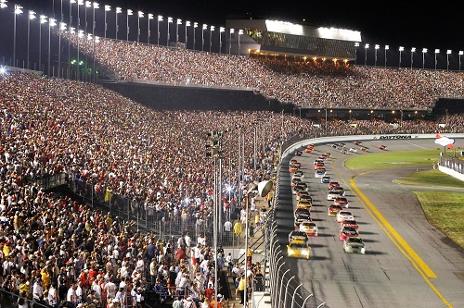
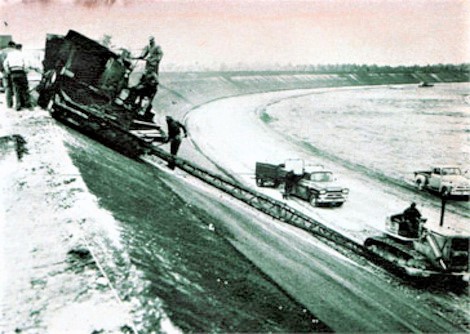
equipment to pave the banking without slipping or rolling down the incline. By December 1958, France had begun to run out of money and relied on advance race ticket sales to complete construction. The first practice run on the new track was on February 6, 1959. Unfortunately there have been many fatalities over the course of the tracks existence. The first came before the first race was even held. Marshall Teague was preparing for a record speed attempt driving his Sumar Special. It was a reconfigured Indy car with a canopy and streamlined fenders. It was on February 11 and as the car entered the turn the high-speed aerodynamic lift caused his racer to spin and flip end-over-end, throwing Teague, still strapped to his seat, from the car. He was killed instantly. On February 22, 1959, 42,000 people attended the inaugural Daytona 500. Its finish was as startling as the track itself: Lee Petty beat Johnny
Beauchamp in a photo finish that took three days to adjudicate. More info on deaths at the track later. Most every major NASCAR star has won at Daytona; either the Daytona 500 or the summer 400 mile event. When racing first started the qualifying races counted as points races; so NASCAR counted wins. For our purposes we'll cover wins NON in qualifying events. Richard Petty has the most career Cup wins; ten in all. Seven in the Daytona 500 and three in the Firecracker 400. One of those wins came in 1979. It was the first time ever a Cup race was going to have live flag to flag coverage. On the final lap Donnie Allison and Cale Yarborough crashed each other out of the race and Petty picked up the win. In what is know as "the fight" Allison and Yarborough climbed out of their mangled machines and decided to settle things with a fist fight as cars came whizzing by. Bobby Allison would stop at the scene on the cool down laps and also get involved. Cale Yarborough has eight wins; four each in the 500 and 400.
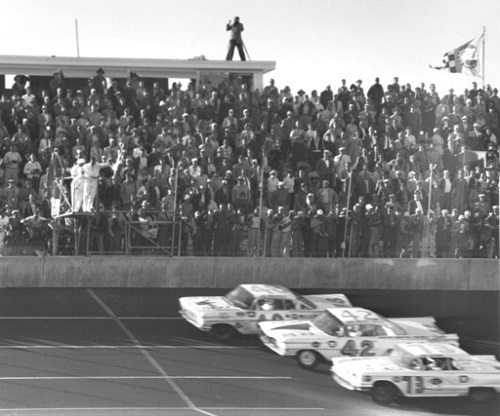
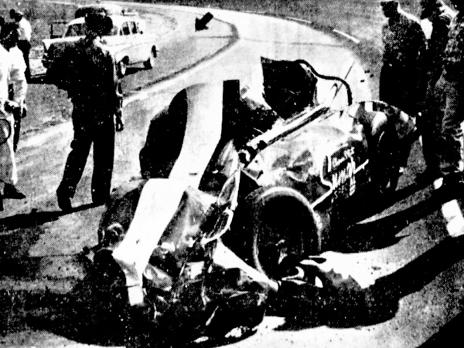
Marshall Teague test crash 1959
Jeff Gordon has three wins in the 500 and added three in the 400. David Pearson only had one 500 win; but claimed the win in the summer on four occasions. Some other notable wins include 1987 when Bill Elliott won the race after setting a record shattering pace in qualifying when he circled the track at 210.364 mph. Another notable win came in 1963 when Tiny Lund drove the Wood Brothers machine to the win as a fill-in driver. Lund was hand-picked by Marvin Panch as he laid in his hospital bed. Panch had been testing a Maserati for the sportscar race. He crashed and the car burst into flames. Lund rushed into the inferno and pulled Panch from the car. In 1964 Indy car ace AJ Foyt would win the Firecracker 400 edging Bobby Isaac by one car length. Foyt to would repeat the win in 1965. In 1972, Foyt wheeled the Wood Brothers car to the win in the 500. Mario Andretti also pulled off a win in the Daytona 500 in 1967. He had a fast car and outran his Holman-Moody teammate Fred Lorenzen to take
the win. Dale Earnhardt one had one Daytona 500 win; but he amassed an amazing 34 wins at the track. He won one of the Twin qualifying races on 12 occasions. He won the Xfinity race seven times while winning the special events of the Bud Shootout and IROC races six times each. Now; more info on deaths at the track On April 4, it hosted a 100 mi USAC Champ Car event which saw Jim Rathmann beat Dick Rathmann and Rodger Ward, at an average speed of 170.26 mph, at the time the fastest motor race ever. George Amick, attempting to overtake for third late in the race, hit a wall and was killed. In an unusual event Byrne Taylor was killed in a powerboat race on Lake Lloyd on June 14 1959. Taylor's runabout spun, flipped and ejected him into the water where he was hit by an onrushing competitor. This made three fatalities within the first four
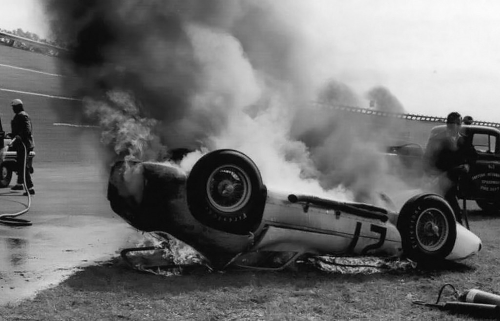
Marvin Panch test crash 1963

"The Fight" - Donnie Allison (left), brother Bobby, and Cale Yarborough (right)
months. Billy Wade was killed during a tire test on January 5th 1965. Don McTavish would parish in a gruesome crash in an ARCA event in February 1969; and the following month Wayne Bartz would die in a motorcycle race. Tab Prince was the first driver to be killed in a NASCAR event. It was the 125 mile qualifying race in February 1970. Prince's Dodge blew a motor heading into the turn and was struck broadside in the drivers door. The impact broke his neck and he died instantly. Friday Hassler died in a multi-car pileup in the 125's in 1972 when he suffered head and neck injuries. Don William was racing in NASCAR's Sportsman division when he spun and was in a pileup which saw him a permanent brain damage. This left him in a coma until his death in May of 1989. Ricky Knotts perished after he suffered head injuries in yet another 125 qualifying race. In 1983 we saw another incident like Williams. Bruce Jacobi crashed and suffered head
injuries, which left him in a coma until he died in 1987. Two racers have been killed in karting accidents; one in 1987 and the other in 1989 in World Karting Association events. 1994 was another dark year for Daytona's Speed Weeks. On February 11, Neil Bonnett would be killed in a practice crash when he spun and slammed into the turn four wall nearly head on. Three days later, Rodney Orr would have a parts failure that caused his car to flip and hit the outside wall roof first; killing him instantly. Dale Earnhardt Sr would be the first driver to perish in an actual Cup race at Daytona. On the final lap in 2001 in the Daytona 500, Earnhardt made contact with another car and shot up the track impacting the wall almost head on. He died instantly. (picture at right; Earnhardt car #3.) Since Earnhardt's death, eight other fatalities have occurred. A total of 40 on site fatalities have occurred, none in NASCAR events.

All Photos copyright and are property of their respective owners
